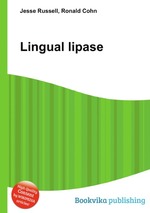Lingual lipase
Jesse Russell Ronald Cohn
бумажная книга
High Quality Content by WIKIPEDIA articles! Lingual lipase is a member of a family of digestive enzymes called lipases, EC 3.1.1.3, that use the catalytic triad of Aspartate (Asp), Histidine (His), and Serine (Ser) to hydrolyze long-chain triglycerides into partial glycerides and free fatty acids. The enzyme catalyzes the first reaction in the digestion of dietary lipid, with diglycerides being the primary reaction product. However, due to the unique characteristics of lingual lipase, including a pH optimum 4.5 -5.4 and its ability to catalyze reactions without bile salts, the lipolytic activity continues through to the stomach. Enzyme release is signaled by autonomic nervous system after ingestion, at which time the serous glands under the circumvallate and foliate papillae on the surface of the tongue (see Figure 1) secrete lingual lipase to the grooves of the circumvallate and foliate papillae. The hydrolysis of the dietary fats is essential for fat absorption by the small intestine, as long chain triacyglycerides cannot be absorbed, and as much as 30% of fat is hydrolyzed within 1 to 20 minutes of ingestion by lingual lipase alone.


